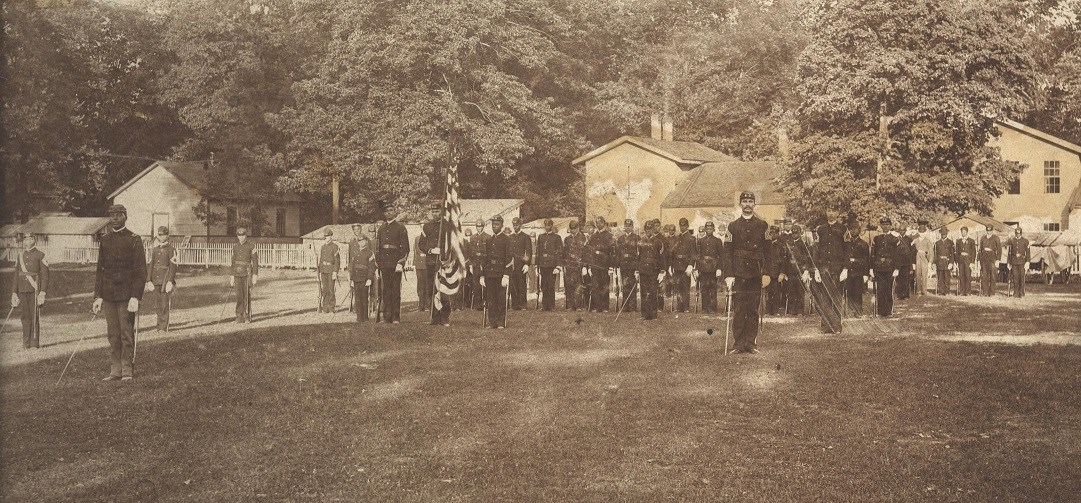Last updated: March 29, 2024
Article
Charles Young Teaching at Wilberforce University

Courtesy of the Coleman Collection, National Afro-American Museum and Cultural Center, Wilberforce, Ohio.
On January 6, 1894, the War Department assigned John Hanks Alexander to detached service at Wilberforce University as professor of military science and tactics. Alexander was the second African American to graduate from West Point. He had roomed with Charles Young at West Point and became his mentor. Scarcely two months after his appointment, on March 26, 1894, while at a barber in Springfield, Ohio, Alexander complained of a severe headache, collapsed, and died. He was buried with full military honors at Cherry Grove Cemetery in Xenia, Ohio. Alexander’s death left Lieutenant Charles Young as the sole African American officer in the United States military.
The Rev. Samuel T. Mitchell, president of Wilberforce University, wrote to President Cleveland and Ohio Senator Calvin Brice requesting that they appoint Young as Alexander’s replacement. Young arrived at Wilberforce University on May 21 to take command of the program.
Just two months after arriving at Wilberforce, Young suffered a personal tragedy. On June 16, his father, Gabriel Young, a Civil War veteran, died of tuberculosis in Zanesville, Ohio. Charles attended his father’s funeral along with his mother, Arminta. After the funeral, Mrs. Young moved to Wilberforce to live with her son. They bought a house together that was just a few blocks from the Wilberforce University campus.
Returning to the university, Young went to work implementing a training regime and developing curriculum. He showed the students how they could overcome adversity and prejudice as he had done at West Point and in the Army officer corps. He also taught classes on military drill, high strategy, and logistics. Young gained a reputation for being a demanding but fair teacher and officer. Within the first year of the program, he garnered support for the program from other members of the university faculty. In addition to military science and tactics, he taught French, chemistry, geometry, and geology.
Young organized his students based upon the West Point model. He formed a cadet battalion, with cadets as the officers and himself as commandant. The battalion comprised about 80 students divided evenly into companies A and B. At the time, military training was mandatory for all male Wilberforce students. The cadets were also required to buy military uniforms and wear them while on campus.
On May 23, 1895, Captain Henry Heistand from the Army Inspector General’s Office made a routine inspection of Young’s program and reported, “Lieutenant Young is very enthusiastic and energetic and has worked very conscientiously for the development of the department so recently established: he enjoys the full confidence and has the active support of the entire faculty and seems eminently qualified both from inclination and ability for the position he occupies.”
By 1898, the Wilberforce military science and tactics program had 113 cadets. Nine students graduated from the program by then. The U.S. Army deemed these graduates qualified to serve as officers and had their names on file with the War Department in Washington, D.C.
Today, the military science and tactics program started by Young is known as the Marauder Battalion Reserve Officers Training Corps (ROTC). It consists of students from Central State University, Wilberforce University, Cedarville University, and Wittenberg University.
Young served as professor of military science and tactics from 1894 to 1898. During that time, he was promoted to first lieutenant. He also formed lifelong friendships there with famed Dayton, Ohio, poet Paul Laurence Dunbar and civil rights activist W.E.B. Dubois. The Wilberforce community became Young’s home when he was on leave from the military. Throughout his life, he returned to Wilberforce to recharge and relax with friends and family.
In the spring of 1898, Young was finishing up his four-year detached service assignment and requested a return to the Ninth Cavalry so he could participate in the Spanish-American War. The War Department denied his request. Being denied was common for officers on detached service at the time. Instead, Ohio Governor Asa S. Bushnell appointed him major of the Ninth Ohio Battalion. He served out the war stateside with the Ninth Ohio Battalion.
Want to learn more about Charles Young at Wilberforce University? Read Black Officer in a Buffalo Soldier Regiment: The Military Career of Charles Young, by historian and author Brian G. Shellum.
